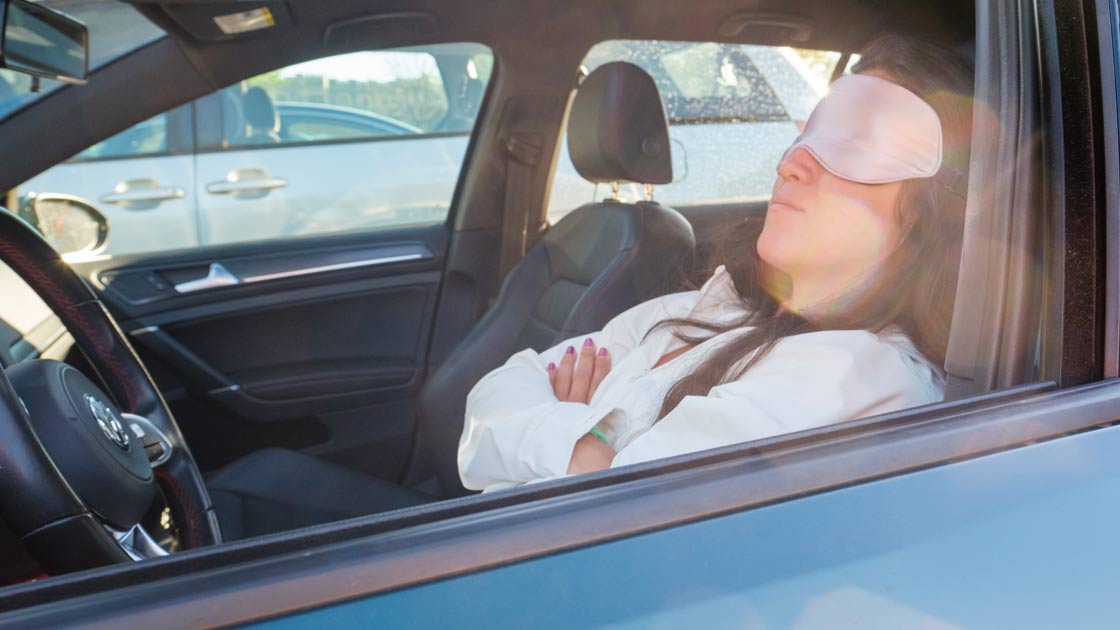Insight
Waking up to the risks of drowsy driving and the solutions at hand
October 22, 2025

My first brush with drowsy driving happened before I even had my license. After I got my learner’s permit, my dad would insist that I drive when he dropped me off for school. One morning, as we drove out of our neighborhood, I was doing my best to tune out whatever my dad was saying when I suddenly heard him shouting. I was about to hit a mailbox!
Apparently, I had nodded off and failed to turn the car with the curve of the road. I righted the path of the car as I felt my heart rate spike and made the rest of the drive to school without incident. (For his part, my dad had no idea that I’d dozed off and simply told me off for “goofing around.”)
Drowsy driving is a form of impaired driving, just like driving under the influence of alcohol or drugs or while distracted by a cellphone. And while many people have a story like mine, the issue gets relatively little attention compared with other problematic driver behaviors. Although there is no single solution for drowsy driving, better awareness of the need for adequate sleep, combined with both tried-and-true infrastructure solutions like rest areas and rumble strips and newer vehicle technology that can jolt us awake or take emergency action, can help mitigate the inevitable human tendency to get tired.
Quantifying the risk
How dangerous exactly is drowsy driving? Studies cited by the National Institute for Occupational Safety and Health suggest that being awake for 17 hours is similar to a 0.05% blood alcohol concentration (BAC). Being awake for 24 hours is like a BAC of 0.10%, above most states’ legal limit of 0.08%. Compared with well-rested drivers, drowsy drivers react more slowly, are less vigilant, have reduced hand-eye coordination, and are worse at remembering the things that they’ve seen.
Of course, as anyone who has staggered through a Monday morning or experienced an after-lunch slump knows, you don’t have to stay awake for 17 hours to be at risk of falling asleep.
Often people don’t realize they’ve fallen asleep, as happened in my case. “Micro-sleeps,” brief moments where one loses consciousness, can occur without warning and happen at any time of day, usually to a person who is behind on sleep. While they only tend to last for a few seconds, that’s more than enough time for something serious to happen when you’re behind the wheel and on a road with other vehicles, especially if you’re traveling at a high speed.
According to police-reported crash data, only 1%-2% of crashes involve drowsy driving, but this is likely an underestimate. Drowsiness is transient and can’t be tested for the way alcohol can be. In single-vehicle crashes in which the driver is killed and there are no passengers, the responding officer is left to essentially make an educated guess as to whether the driver fell asleep or something else happened.
One naturalistic study of driving behavior suggests that dozing off at the wheel is more common than people think. The researchers outfitted participants’ vehicles with cameras and other instruments to watch how they drove over a long period of time. Looking at the driver’s apparent alertness leading up to crashes, they estimated that about 9%-10% of crashes likely had drowsiness as a contributing factor.
The solution seems obvious — we should all just prioritize sleep! — but this doesn’t play out in practice for many Americans. In a survey of people 18 and over by the Centers for Disease Control and Prevention, 33% of adults reported getting less than seven hours of sleep a night. That’s the amount sleep experts consider adequate for most adults, but some groups, including teens, need much more.
Realistic solutions
Clearly, we can’t just snap our fingers and get everyone to sleep more. But that doesn’t mean we can’t take steps to address drowsy driving.
Infrastructure changes, such as adding rumble strips to medians and roadway edges and building more rest stops on highways, can help reduce drowsy-driving crashes. Research finds that roads with abundant rest areas where people can take a break see fewer crashes than those that lack such facilities.
Greater awareness of the dangers of fatigue could help encourage more people to use existing rest areas. Many people assume that if they blast loud music or open the windows for cold air they won’t fall asleep, but research has shown those methods are minimally effective. A short nap, on the other hand, can make a difference.
Wider availability of some driver assistance features could also help. Technology like lane departure warning can act like an in-vehicle rumble strip and jolt a driver awake by vibrating the steering wheel or sounding an alert if they veer out of the lane.
Recent years have seen automakers develop in-vehicle systems to intervene if drivers tune out while driving. These types of systems can recognize drowsiness in a few different ways — for example, by tracking excessive swaying in the lane or by using driver-facing cameras to monitor the driver’s gaze.
Subaru’s DriverFocus system uses a driver-facing camera to detect when the driver is drowsy or distracted. In a recent IIHS study, 9 out of 10 people with DriverFocus-equipped vehicles reported using the system most or all of the time. Most users report liking the system and feeling that it makes driving safer.
Of course, no technology can serve as a replacement for an alert, awake driver behind the wheel. In particular, partial automation systems that keep the vehicle in the lane and maintain a set following distance shouldn’t be used as a crutch for drowsy drivers. Recently, Tesla alarmed safety experts when its in-vehicle messaging began suggesting that drivers who appear drowsy should turn on its problematically named “Full Self-Driving” feature. This message conflicts with Tesla’s own instructions, which note that drivers must pay attention and be ready to take control at all times.
I wish I could report that my high school brush with drowsy driving was my last, but drowsiness is sneaky and still occasionally catches me off guard. Thankfully, existing countermeasures, my own understanding of the risks and — to be honest — luck have kept these moments from becoming catastrophes. I do my best to be aware of my own fatigue, use available technology for support, and take advantage of available rest areas when needed. Transportation planners and vehicle manufacturers should prioritize proven solutions to help all drivers stay awake.
